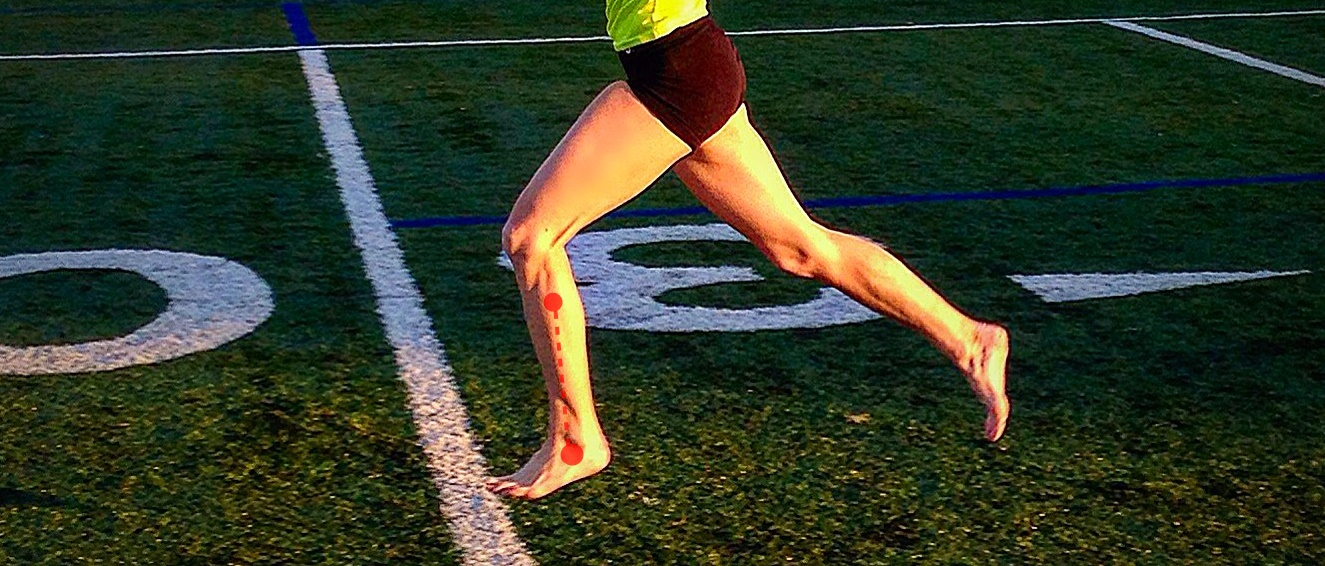Peroneal tendinosis is when pain is experienced on the outside of the junction where the foot meets the ankle and may be a catalyst for other injury if you run with this injury. The condition however, is not always the result of biomechanical impairments during running. This area can become irritated and inflamed if your footwear is too loose where the fabric of the shoe constantly rubs against the area during running, causing the area to swell.
In many cases, the swelling may not be painful, but it can lead to tendon pain farther up the leg, particularly the peroneus longus.
Below shows the pain pattern of peroneal tendinosis.
What is Peroneal Tendinosis And How Can Forefoot Runners Avoid It
When the peroneal tendon of the foot/ankle complex is inflamed, it may be more problematic for forefoot runners because forefoot running requires greater ankle stabilization via the peroneal tendon. Therefore, a forefoot strike landing pattern may further irritate the tendon and cause pain farther up the leg.
How so?
The peroneal tendon has an important role in running, especially in forefoot running, in that its in-charge of minimizing internal rotation (Ashton-Miller et al. 1996; Sinkjaer et al. 1988), pronation-eversion control, hindfoot support alignment, proper positioning of the foot at touchdown, and ankle stabilization during the stance phase of running (Fong et al. 2012; Heckman et al. 2009).
When the peroneal tendon is out of commission, i.e injured or inflamed, it undergoes viscoelastic degradation where its role as an ankle stabilizer becomes compromised.
The potential consequence of running with this injury is excessive supination ankle-inversion during stance which overloads the ankle ligaments, leading to inadequate shock absorption during initial contact phase of running (Hsu et al 2014; Nigg, 2011; Park et al. 2012). Forefoot running may worsen the condition because it naturally places more tensile loads on the passive stabilizing ligaments and tendons of the ankle joint during stance (Philbin et al. 2009), suggesting that peroneal tendinosis may worsen if forefoot running is continued.
If you are like me, you are stubborn and will try to run with any injury, but should you really be running with this kind of injury? Besides, it’s only a ligament injury, not a bone injury…..right?
The problem with running with peroneal tendinosis is that it causes problems in other areas of the lower leg, such as trauma to the peroneus longus –which is farther up the leg, resulting in pain on the outside of the calf. For example, Ziai et al. 2016 found that peroneal tendinosis accompanied both peroneus brevis tendinosis and peroneus longus tendinosis, suggesting that peroneal tendinosis certainly is a predisposing factor for additional lower leg injuries, so maybe it’s best you rest for the time being.
Another reason you should avoid running is that the condition causes reduced active lateral ankle stabilization, impairing both active and passive stabilizing abilities of the peroneal tendon, which may increase rotational workloads on the talus ( Ziai et al. 2013).
Ultimately, when this little tendon is inflamed, it can disrupt the kinetic chain of events on the leg during running, resulting in more injuries. I hate to say it, but since peroneal tendinosis seems to be a predisposing factor for other injuries, it’s best not to run until the ankle swelling has gone.
More From Run Forefoot:
How Barefoot Walking Reduced Inflammation
Best Shoes for Forefoot Runners
Forefoot Strike vs Heel Strike – Impact Differences
What Does a Proper Forefoot Strike Look Like?
References:
Ashton-Miller JA, Ottaviani RA, Hutchinson C, Wojtys EM. What best protects the inverted weight bearing ankle against further inversion? Evertor muscle strength compares favorably with shoe height, athletic tape, and three orthoses. Am J Sports Med, 1999; 24(6):800–809.
Fong DT, Chu VW, Chan KM (2012) Myoelectric stimulation on peroneal muscles resists simulated ankle sprain motion. J Bio-
mech 45(11):2055–2057.
Fujii T, Kitaoka HB, Luo ZP, Kura H, An KN (2005) Analysis of ankle-hindfoot stability in multiple planes: an in vitro study. Foot
Ankle Int 26(8):633–637.
Heckman DS, Gluck GS, Parekh SG (2009) Tendon disorders of the foot and ankle, part 1: peroneal tendon disorders. Am J Sports Med 37(3):614–625
Hsu AR, Gross CE, Lee S, Carreira DS (2014) Extended indications for foot and ankle arthroscopy. J Am Acad Orthop Surg 22(1):10–19
Konradsen L (2002) Sensori-motor control of the uninjured and injured human ankle. J Electromyogr Kinesiol 12(3):199–203.
Nigg BM (2001) The role of impact forces and foot pronation: a new paradigm. Clin J Sport Med 11(1):2–9.
Park HJ, Lee SY, Park NH, Rho MH, Chung EC, Kwag HJ (2012) Accuracy of MR findings in characterizing peroneal tendons disorders in comparison with surgery. Acta Radiol 53(7):795–801,
Philbin TM, Landis GS, Smith B (2009) Peroneal tendon injuries. J Am Acad Orthop Surg 17(5):306–317.
Sinkjaer T, Toft E, Andreassen S, Hornemann BC (1988) Muscle stiffness in human ankle dorsiflexors: intrinsic and reflex components. J Neurophysiol 60(3):1110–1121
Ziai at el. Peroneal tendinosis as a predisposing factor for the acute lateral ankle sprain in runners. Knee Surg Sports Traumatol Arthrosc, 2016, 24:1175–1179.
Ziai P, Benca E, von Skrbensky G, Graf A, Wenzel F, Basad E, Windhager R, Buchhorn T (2013) The role of the peroneal ten-
dons in passive stabilisation of the ankle joint: an in vitro study. Knee Surg Sports Traumatol Arthrosc 21(6):1404–1408
Bretta Riches
BSc Neurobiology; MSc Biomechanics candidate, ultra minimalist runner & founder of RunForefoot. I was a heel striker, always injured. I was inspired by the great Tirunesh Dibaba to try forefoot running. Now, I'm injury free. This is why I launched Run Forefoot, to advocate the health & performance benefits of forefoot running and to raise awareness on the dangers of heel striking, because the world needs to know.
Latest posts by Bretta Riches (see all)
- Can You Run In Barefoot Shoes? Yes, But DON’T Heel Strike! - 21/07/2024
- Why Cushioned Running Shoes Are Really Bad for Your Feet - 19/07/2024
- Do Cushioned Running Shoes Cause Injuries? - 17/07/2024

